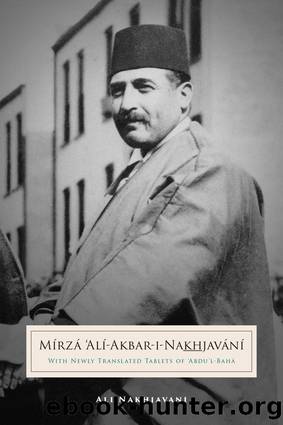Mirza Ali-Akbar-i-Nakhjavani by Ali Nakhjavani

Author:Ali Nakhjavani
Language: eng
Format: epub
Publisher: Bahai Publishing
Published: 2018-11-26T00:00:00+00:00
Appendix II
Digest of Information from Ishráq-KhávarÃâs Epitome of the History of the Baháâà Faith in Bákú
At the time when Siyyid âAbduâl-KarÃm was resident in Bákú, a number of persons became believers in the Cause of the Báb. After his passing, the believers of Bákú were left shepherdless, not knowing where to turn, until Mullá Ṣádiq the Martyr, who previously, whilst in Qazvin, had embraced the Cause of both the Báb and Baháâuâlláh, returned to Bákú. Even before his arrival, tidings of the Revelation of Baháâuâlláh had reached that city, and a few persons had recognized His claim, among them âAbduâl-Manáf, Mustafá Bik, Ãqá Bikov, Zargaruf-i-Buzurg, Ãqá Javád-i-SulaymánÃ, and several other soulsânone of whom had a sufficient grasp of the Cause. When Mullá Ṣádiq the Martyr arrived in Bákú, he brought with him a copy of the Kitábi-Ãqán and many other Tablets and Writings; and since, during his previous three-month sojourn in Qazvin, he had acquired from the Baháâà teachers a sufficient understanding of the fledgling Faith, his arrival in the Caucasus was a great bounty for the believers.
Mullá Ṣádiq was immediately successful in convincing a number of persons of the truth of the Cause; among them Mullá Abú-Ṭálib-i-KarÃmov, âAbduâl-Muâmin-i-Zargaruf, MÃr âAllám, and Karbiláâà Ãqá KishÃy-i-âAlÃov.1 In Ganjih, Kúk-Cháy,2 Salyán,3 and Bálá-Khánlà (Bálá-KhánÃ) too the Faith was proclaimed, and a number of persons embraced it. Once the Faith was established in Bákú, and the friends became sufficiently informed of its nature, regular teaching activities were initiated, and inquirers would visit the homes of the friends in order to find out about the new Cause. In consequence, the ShÃâa âulamá began inflicting harm and injury on those who had enlisted under its banner.
When MÃr âAllám embraced the Cause, he made his home a âteaching houseâ (âbayt-i-tablÃghâ). Hence, from 1890 onwards the Bákú friends had a meeting-place of their own; and this house became subsequently the ḤaáºÃratuâl-Quds of Bákú. Then, in 1906 the friends set about constructing a purpose-built ḤaáºÃratuâl-Qudsâa development which caused an outcry from the local Muslims, who protested that the BaháâÃs were constructing a âmosque,â which it was incumbent upon them to destroy.
Ustád âAlÃ-Ashraf and Ustád Bálá were two brothers who were in charge of the building operations. The latter, who was something of a âstrongman,â and quite intrepid, announced that he would kill whoever presumed to destroy the ḤaáºÃratuâl-Quds. Ustád Bálá, who was always present on the building site, had secured the services of a government agent in order to ensure that disorderly members of the populace should not create disturbances. A number of the BaháâÃs of Bálá-KhánlÃ, and the youth of Bákú, as well as a company of elders, were also continually present in the ḤaáºÃratuâl-Quds, keeping watch against the possibility of trouble. Ustád Ashraf and Ustád Bálá, moreover, in view of the building operations, always had on hand some fifty permanent workers and builders. This workforce too was on its guard lest anyone should attack the building; while Ustád Bálá had a license to bear small arms about his waist.
Download
This site does not store any files on its server. We only index and link to content provided by other sites. Please contact the content providers to delete copyright contents if any and email us, we'll remove relevant links or contents immediately.
| Baha'i | Cults |
| Demonology & Satanism | Eckankar |
| Egyptian Book of the Dead | Freemasonry |
| Messianic Judaism | Mysticism |
| Scientology | Theism |
| Tribal & Ethnic | Unitarian Universalism |
The Four Agreements by Don Miguel Ruiz(6550)
Breaking Free by Rachel Jeffs(4121)
The Hatha Yoga Pradipika (Translated) by Svatmarama(3187)
120 Days of Sodom by Marquis de Sade(3124)
Member of the Family by Dianne Lake(2282)
The Tao of Physics by Fritjof Capra(2208)
The Psychedelic Gospels: The Secret History of Hallucinogens in Christianity by Jerry B. Brown(2097)
The Road to Jonestown by Jeff Guinn(2000)
Going Clear: Scientology, Hollywood, and the Prison of Belief by Lawrence Wright(1912)
Going Clear by Lawrence Wright(1897)
Uriel's Machine by Christopher Knight(1843)
The Grand Grimoire: The Red Dragon by Author Unknown(1736)
The Gnostic Gospel of St. Thomas by Tau Malachi(1715)
Key to the Sacred Pattern: The Untold Story of Rennes-le-Chateau by Henry Lincoln(1576)
The Malloreon: Book 02 - King of the Murgos by David Eddings(1534)
Waco by David Thibodeau & Leon Whiteson & Aviva Layton(1509)
The New World Order Book by Nick Redfern(1507)
The Secret of the Temple by John Michael Greer(1443)
Animal Speak by Ted Andrews(1425)
